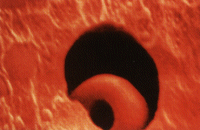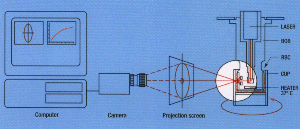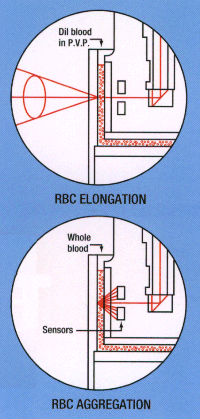 Manual home
Manual home
 Send Feedback
Send Feedback

 Print
Print
Principle of operation Lorrca Maxsis
In order to evaluate the flowing capacity of blood in different parts of the body it is important to have a technique available for the accurate measurement of Red Blood Cell (RBC) properties.
|
|
|
|
The LoRRca MaxSis is therefore an indispensable instrument. It uses a Couette geometry with a static BOB and a rotating cylinder (CUP) to create a simple shear flow.
Cell deformability A thin layer of red blood cell suspension is sheared between two concentric cylinders. The rotation of the outer cylinder (CUP), causes deformation (elongation) of the red blood cells.
|
|
Cell aggregation
Various aggregation indices are determined in whole blood by means of reflection measurements. The software instructs the operator when to insert the test suspension. A laser diode, mounted in the BOB, serves as light source. The reflected light is sensed by a photodiode.
The RBC-aggregation software is written for creating the syllectogram and for measuring the threshold shear rate at which RBC aggregation is just prevented.
The default setting is the tri-exponential model investigator is enabled to select a syllectogram-fitting model containing one to three exponents, which describes the whole syllectogram, including the upstroke. It is possible to change the settings:
- The uni-exponential model is interesting to study, e.g., RBC-shape recovery in buffer solution
- The conventional bi-exponential model describes the aggregation process while the tri-exponential model includes both RBC-shape recovery and aggregation
See Also |
 Mechatronics home
Mechatronics home
 Send Feedback
Send Feedback

 Print
Print
|
Page last reviewed: 12/11/2018 10:58:18 (Version: 5.08 (24-04-2023) MRN-231-EN) ©2022 RR Mechatronics |





